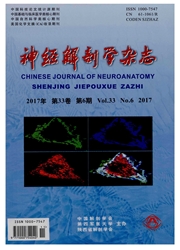

 中文摘要:
中文摘要:
目的:探讨人参皂甙-Rd(G-Rd)对大鼠神经病理性痛的镇痛效果及其机制。方法:成年雄性SD大鼠(30只)随机分成五组:空白对照组(blank control)、坐骨神经分支选择损伤组(spared nerve injury,SNI)、假手术组(sham operation)、SNI+saline(腹腔注射,i.p.)组、SNI+G-Rd(i.p.)组。行为学用von Frey法测定上述各组手术侧后肢机械缩足反射阈值(PWMT),以评定大鼠SNI术后痛敏变化以及人参皂甙-Rd的镇痛效果;用免疫荧光法检测对比上述各组大鼠脊髓L4-6节段背角内谷氨酸样和N-甲基-D-天冬氨酸受体2A/B亚单位(NR2A/B)样免疫阳性物的平均荧光强度(MFI)。结果:SNI术后10 d,手术侧PWMT值明显低于空白对照组和假手术组,术后20 d达到最低值,SNI+G-Rd组PWMT值明显高于SNI+Saline组(P〈0.05)。免疫荧光染色显示SNI术后20 d,脊髓L4-6节段手术侧背角内谷氨酸样和NR2A/B样免疫阳性产物的MFI明显高于空白对照组和假手术组(P〈0.05);SNI+G-Rd组脊髓L4-6节段手术侧背角内的谷氨酸样免疫阳性产物的MFI明显低于SNI和SNI+S组(P〈0.05),而NR2A/B的MFI未见显著变化(P〉0.05)。结论:人参皂甙-Rd可显著改善SNI引起的大鼠痛过敏行为,其可能的脊髓机制之一是与其有效地减少相应脊髓节段背角内谷氨酸的含量有关
 英文摘要:
英文摘要:
Objective:To investigate the effect and mechanisms of the analgesis of Ginsenoside-Rd(G-Rd) on neuropathic pain.Methods:Thirty male SD rats were randomly divided into five groups:blank control,SNI,sham operation,SNI+Saline(intra-peritoneal injection,i.p.),and SNI+G-Rd(i.p.) groups.We measured paw withdrawal mechanical thresholds(PWMT) using calibrated von Frey filaments to stimulate the glabrous surface of the lateral plantar of the hindpaw.Immunofluorescent staining was used to measure the mean fluorescent intensity(MFI) of glutamate-like and N-methyl-D-aspartale receptor-2-A/B subunit(NR2A/B)-like immunoreactivities in the spinal dorsal horn(L4-6) in five groups.Results:At 10 d after SNI,the mean PWMT value on SNI side revealed clearly lower than that of blank control and sham operation groups,and dropped to the lowest at 20 d.The PWMT value significantly increased in SNI+G-Rd group compared with that of SNI+saline group(P〈0.05).The immunofluorescent staining revealed that the MFI of glutamate-like and NR2A/B subunit-like immunoreactivities in the dorsal horn of the SNI side in spinal cord L4-6 segments showed significantly higher compared with that of blank control and sham operation groups.In SNI+G-Rd group,the MFI of glutamate-like immunoreactivities revealed clearly lower than that of SNI and SNI+saline groups(P〈0.05).However,the MFI of NR2A/B subunit-like immunoreactivity did not show significant changes in three groups mentioned above.Conclusions:G-Rd revealed obvious analgesic effect on neuropathic pain induced by SNI.The decrease of the glutamate content in the dorsal horn of spinal cord L4-6 segment was a possible mechanism of the analgesic effect of G-Rd
 同期刊论文项目
同期刊论文项目
 同项目期刊论文
同项目期刊论文
 期刊信息
期刊信息
